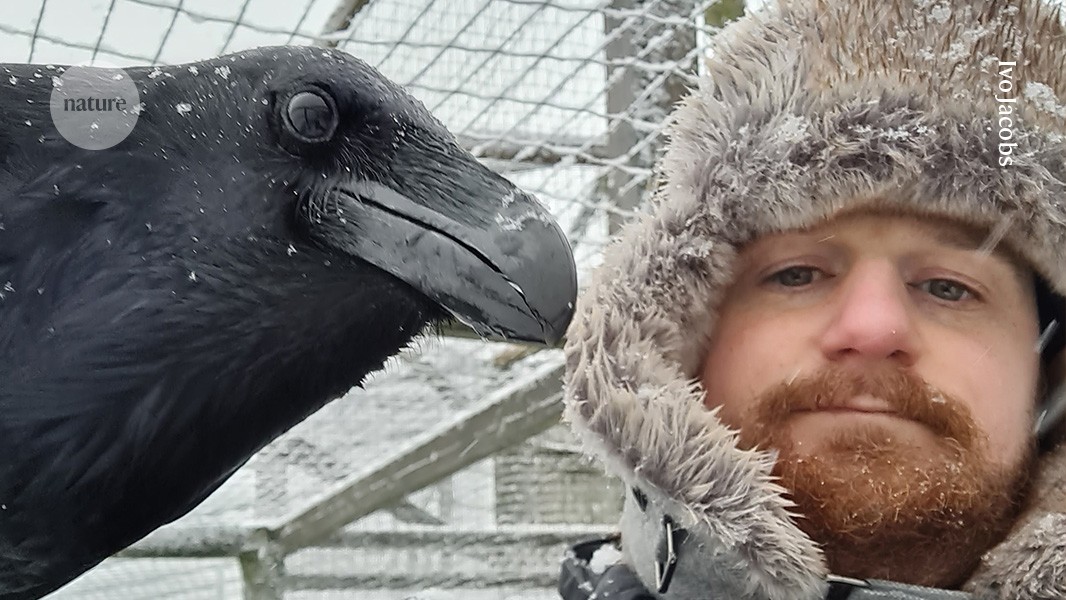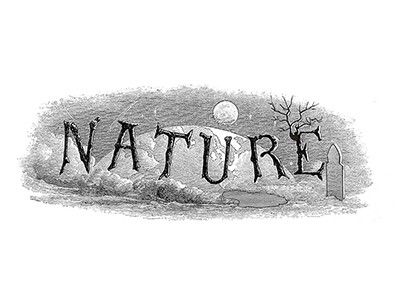Halloween, celebrated on 31 October, originated with the ancient Celtic festival of Samhain, during which people lit bonfires and wore costumes to ward off spirits. Today, it’s a holiday synonymous with not just witches and ghouls, but also crows, bats, owls, snakes and other ‘spooky’ creatures. Nature asked nine scientists what inspired them to study unorthodox animals and plants and what they want the world to know about their favourite organisms, and gave them the chance to correct misconceptions around the much-maligned reputations of these flora and fauna.
IVO JACOBS: The ‘playful genius’ of crows
Ivo Jacobs studies the evolution of cognition at Lund University in Sweden.
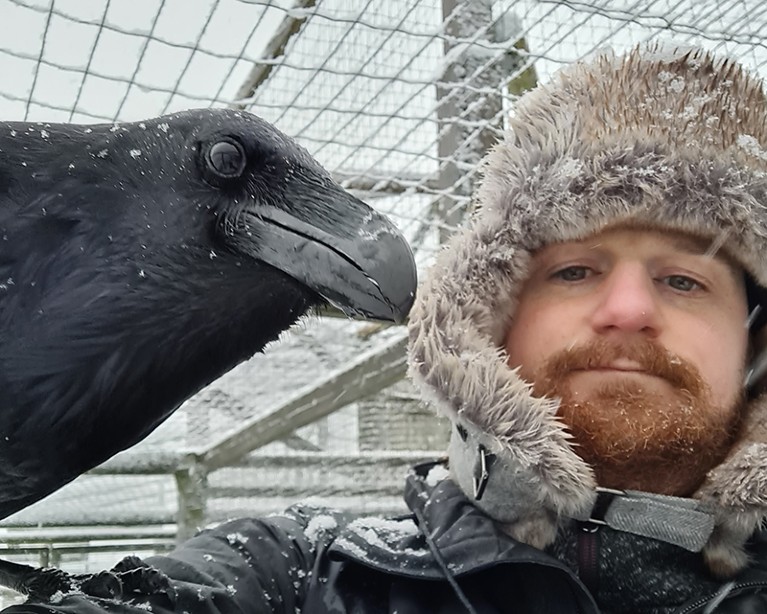
Ivo Jacobs says that ravens compete to participate in his group’s research on cognition.Credit: Ivo Jacobs
Corvids, birds in the crow family, have quite the mythological status — from ominous tricksters to playful geniuses — across diverse cultures. I have always been fascinated by how creatures with walnut-sized brains and no hands have cognitive capacities similar to those of great apes1, despite the evolutionary gap of 320 million years. This suggests that complex cognition has evolved independently several times. Cognition is a solution to buffer against environmental changes that occur faster than evolution. I examine the problem-solving abilities that help corvids, such as the common raven (Corvus corax), to adjust to changing conditions.
Misconceptions about corvids are rife: they are often viewed as unpleasant and dangerous birds, exhibiting behaviours such as pecking out of frustration. However, they are more likely to gently preen your eyebrows than to try plucking out your eyes. My chances of leaving the aviary with a peck mark are lower than the likelihood of them undoing my shoelaces, stealing my hat or stashing food in my pockets. I once had the surreal experience of explaining to airport security why a piece of rotten liver had fallen out of my jacket.
Our corvids enjoy participating in research — essentially playtime for food rewards — so much that they compete to enter the testing room. Another widespread myth is that corvids have a proclivity to steal shiny things. Our research revealed that they prefer round objects that are not shiny2. Sometimes, they will even forgo food to take a small wooden ball. Their extensive play with objects fuels their innovative tool use.
LINFA WANG: Bats help to unravel infectious diseases
Linfa Wang studies zoonotic diseases and bat immunology at Duke-NUS Medical School in Singapore.
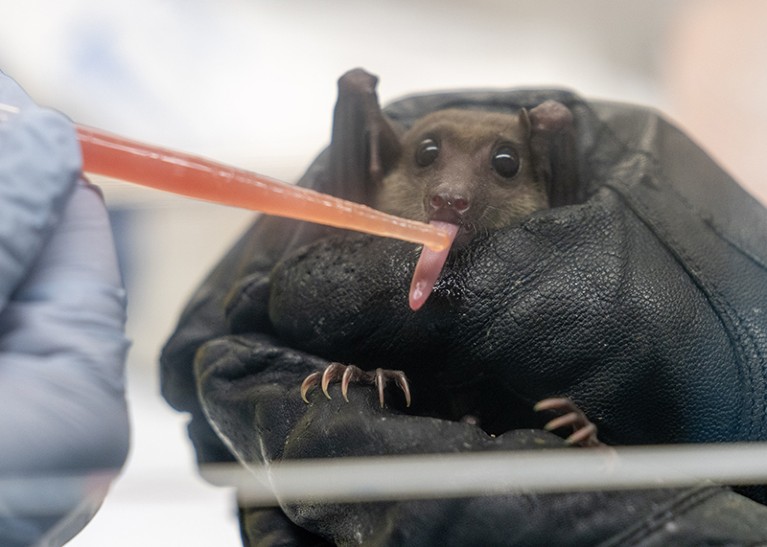
Studying viruses in bats can help to better understand human disease, says Linfa Wang.Credit: Dr Feng Zhu/Duke-NUS
I became interested in bats because the viruses that my research group studies, including Hendra virus, Nipah virus and SARS-CoV-1, are transmitted by them. The question of why bats can carry so many viruses without showing signs of disease propelled me to study bat genomics and immunology. The more I study these creatures, such as the cave nectar bat (Eonycteris spelaea), the more fascinated I am by their unique traits — from their relatively long lifespan to their resistance to cancer. We are motivated to discover bat-inspired therapeutics to treat disease in people.
Many people mistakenly blame bats for viral outbreaks of severe acute respiratory syndrome and COVID-19. I try to emphasize that it is not the bats’ fault. They have co-existed with these viruses for millions of years, and it is human activities that have led to these spillover events.
This field was very small 15–20 years ago, and it was hard to get funding and standard research tools. As a pioneering ‘batman’, I worked to expand the field. Here are some tips to do so for your favourite organism: first, focus on gathering essential tools and reagents, such as cell lines, a breeding colony, sequenced genomes and organism-specific antibodies. Second, share your resources with as many groups as possible. Third, actively promote and participate in activities in your organism’s research community, including workshops and symposiums. Fourth, convince funding bodies to expand this area of research. And finally, solicit commercial companies to support your efforts to develop products inspired by the organism.
DAVID HU: Physics behind cat tongues and wombat poo
David Hu is a biophysicist at the Georgia Institute of Technology in Atlanta.
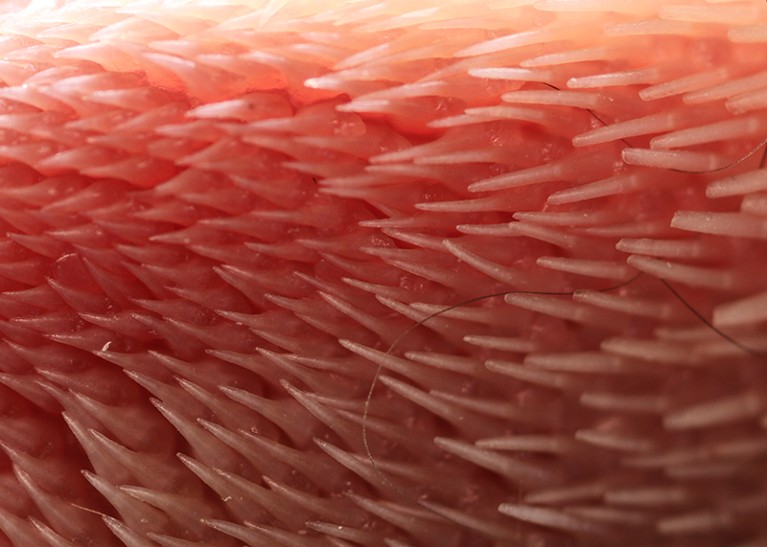
Cat tongues look creepy in a close-up, and inspire better brush designs.Credit: Alexis Noel and David Hu
I study the physics of animal form and movement, with the goal of designing bio-inspired robots and devices. I have studied how a cat’s tongue functions as a cleaning brush, how wombats produce cube-shaped poo and how elephants reach with their trunks. My work gathers inspiration from a variety of unconventional model organisms, and they have a key role in bio-inspired design of complex materials and soft adaptable robots.
Many people think bio-inspiration is simply about searching for ideas by watching animal videos on the Internet. Long ago, biologists taught me to work with animals in person, filming them and collecting biological samples. I have since worked with zoos, aquariums, museums and field stations to find animal subjects. This process takes longer, but leads to so many discoveries.
Animals do not usually do what you want. Studying each species requires techniques that I have learnt from animal specialists. An hour of networking can save days or months in the laboratory or field, turning seemingly impossible experiments into achievable ones.
A big misperception about animals is that scientists already know everything about them. The simplest-looking movements, such as the leap of a cat or shake of a dog, cannot be robustly replicated by robots. Understanding how animals can move so well in unpredictable environments will help us to build devices that can do the same.
MOYUAN CAO: Cacti offer a prickly way to collect water
Moyuan Cao is a materials scientist at Nankai University in Tianjin, China.
After millions of years of evolution, plants and animals have developed superb abilities to manipulate and collect fluids. These processes are efficient, energy-saving and diverse — and offer numerous ideas to improve technology to collect water in arid environments. My work focuses on fluid-transport processes on bio-inspired interfaces that mimic cactus spines. In cactus clusters, a water droplet on the conical spine moves from the spine tip to its root. When the droplet reaches the root, the hydrophilic trichome — a fine outgrowth on the surface — rapidly absorbs it into the stem.
My team has designed a fog collector, which acts like a cactus spine. These cactus-like devices are useful for collecting water in arid, foggy regions with no surface water, for example deserts near the sea, such as the Namib desert in southern Africa, and coastal mountain ranges, such as those near Antofagasta, Chile. Nature might have already found the best solution for unique environments, and my role is to identify the environmental conditions where those solutions can be best applied.
DRIES KUIJPER: Debunking the false folklore about wolves
Dries Kuijper is an ecologist at the Mammal Research Institute of the Polish Academy of Sciences in Białowieża.
Centuries ago, the balance between humans and wolves was different — there was more wilderness, more wolves and fewer people. Back then, most wolf–human accidents involved wolves with rabies, whose behaviour is very unnatural, and this led to the folklore that wolves are dangerous. Interestingly, a review of all documented cases of wolves attacking humans from 2002 to 2020 shows that, despite large increases in wolf numbers in human-dominated landscapes of Europe, there has not been an increase in attacks (see go.nature.com/4iuop). No fatal attacks, and only a few bite incidents, have been documented in the past 20 years in Europe. Wolves are not dangerous to us, but people should respect the boundaries needed to keep wolves wild.
From the archive: Halloween horrors
I study how grey wolves (Canis lupus) affect the functioning of ecosystems in the Białowieża forest in eastern Poland and in other places in Europe. I was inspired by the reintroduction of wolves in Yellowstone National Park in Montana, Idaho and Wyoming, and how it caused trophic cascading effects: the wolves decreased the density of prey species, such as deer, which reduced the deer’s feeding on young trees, and that facilitated tree regeneration. But I realized pretty quickly that the Białowieża forest is very different from Yellowstone’s vast wilderness. Outside the Białowieża National Park, the forest hosts plenty of human activities. People live and hunt in the forest, and many tourists visit it. This directly or indirectly influences the behaviour of deer, which the wolves prey on, and how wolves use the landscape to generally avoid humans.
Wolves are not afraid of human-dominated landscapes in Europe and have recolonized many countries. That has resulted in more human–wolf conflicts — especially due to livestock predation — but it also raises the scientific question how the presence of wolves can reshape their environment. In human-dominated landscapes that have been modified and restructured, wolves often engage in interactions with other species in different ways, which can have different influences on ecosystems3.
RIZMOON N. ZULKARNAEN: Ghost orchids ‘haunt’ the forest
Rizmoon N. Zulkarnaen is a plant conservationist at the National Research and Innovation Agency in Jakarta, Indonesia.
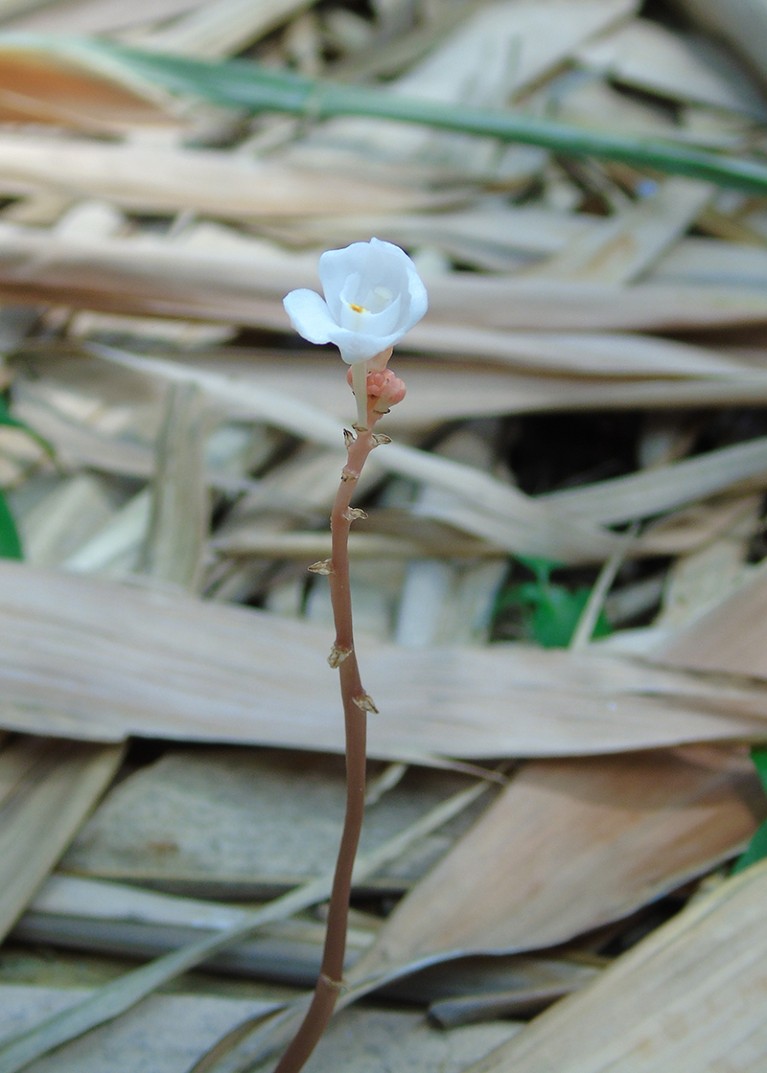
The ghost orchid floats above the forest floor — a fragile sentinel of a healthy ecosystem.Credit: Rizmoon Nurul Zulkarnaen
As a plant conservationist, I am fascinated by the biodiversity of endemic and threatened plants, and recognize the urgent need for conservation, particularly in Indonesia. I study Didymoplexis pallens, known as the ghost orchid because of its pale, ethereal appearance, which makes it look as though it is floating. These orchids are entirely leafless, lack chlorophyll and often grow on decaying plant matter in dense forests.
Ghost orchids are epiphytic plants, meaning they grow on the surface of other plants: they depend on relationships with mycorrhizae, or symbiotic fungi, for nutrients. In the past few years, bamboo litter in their habitat, an important source of organic material for mycorrhizae, has significantly decreased or even disappeared. This was due to land clearing in the Bogor Botanical Gardens in Indonesia, for beautification and land management. As a result, the population of ghost orchids has drastically declined.
I found that ghost orchids have a significant role in their ecosystem, acting as indicators of environmental health owing to their reliance on specific conditions, such as soil type, humidity and the amount of light, to grow. I do fieldwork with students to foster a community centred on plant conservation. We have reframed ghost orchids from merely rare plants to fragile components of a larger ecosystem that are crucial for biodiversity conservation.
JANE HILL: Corpse plants reflect nature’s cleverness
Jane Hill is a chemical engineer at the University of British Columbia in Vancouver, Canada.
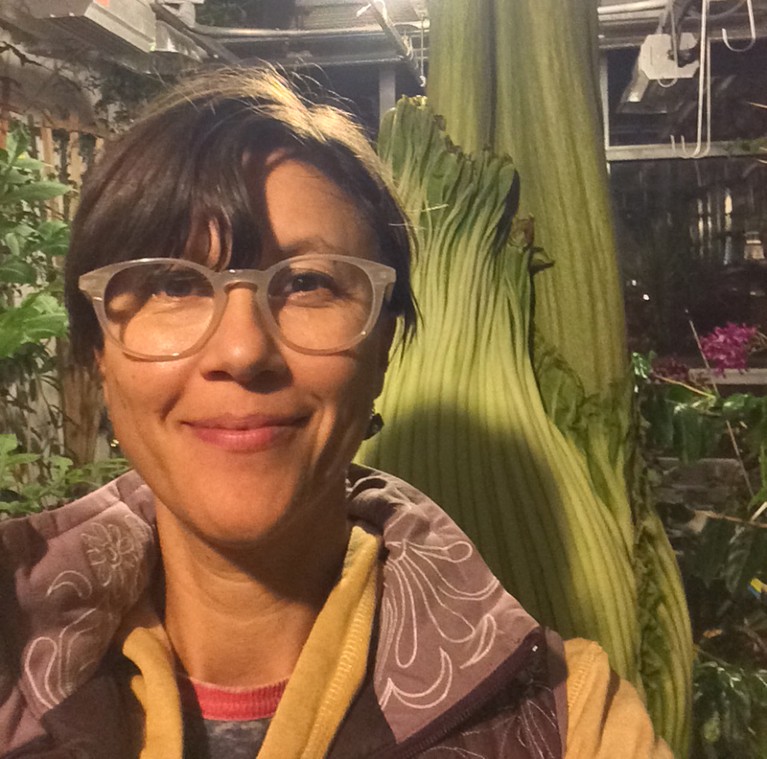
Jane Hill with a corpse plant, which can mimic odours produced during human and animal diseases.Credit: Jane E. Hill
The rare flowering of the corpse plant is a wonderful example of the artistry and cleverness of nature. Plants must attract creatures to help them reproduce, and the corpse plant (Amorphophallus titanum) uses striking colours and odours to attract insect pollinators. My research team investigates molecules related to metabolism in human and animal disease, which we test as potential diagnostic biomarkers. We discovered that, during certain human infections, the odours that people emit are similar to those of corpse plants. We want to know how the plant evolved to mimic the smells of humans and other animals.
Very few people study this rare plant, which grows in the tropical rainforest in Sumatra, Indonesia. Currently, my team studies the corpse plant as a hobby, using our tools to discover volatile molecules that give rise to odour. Although my team is not highly connected to the botanists studying corpse plants, our curiosity about which volatile molecules attract which insects, for example, has led to discussions with people studying insects, genetics and ecology. These fruitful exchanges stimulate our work, which helps us to better understand the smelly, odour-causing molecules produced during human disease. Those molecules might one day allow us to develop tools to diagnose diseases more quickly.
DANIEL RABOSKY: Protect lizards to preserve ecosystem diversity
Daniel Rabosky is an ecologist at the University of Michigan in Ann Arbor.
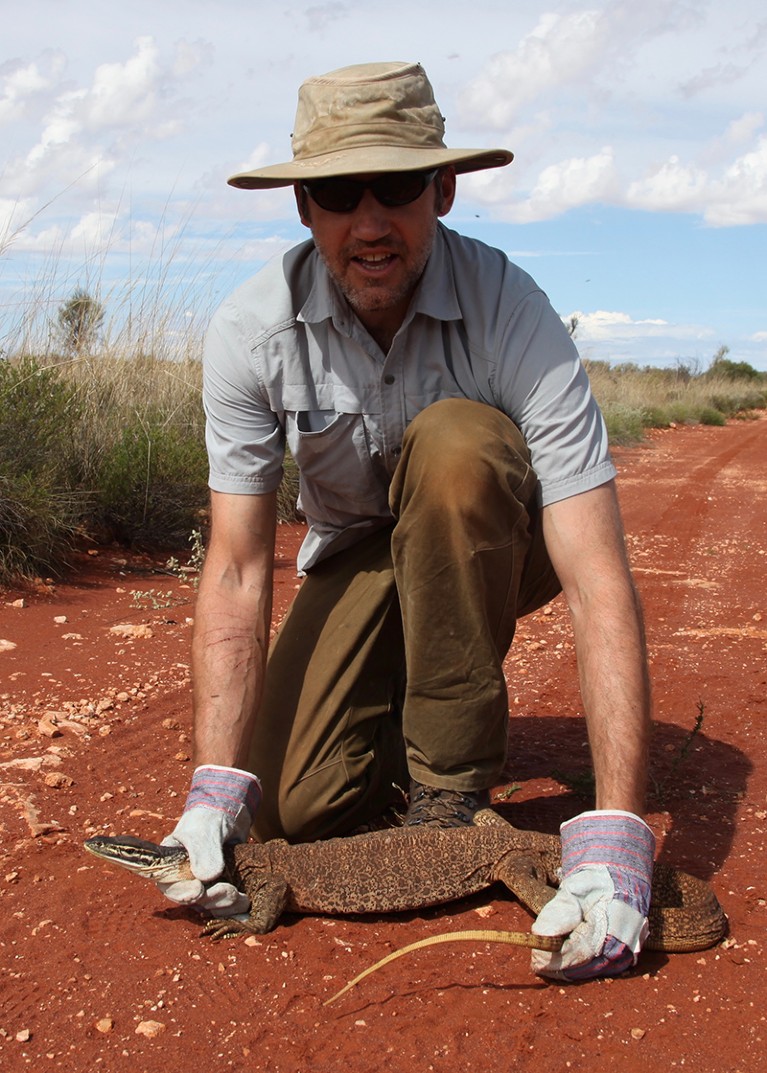
Ecologist Daniel Rabosky, holding a yellow-spotted monitor (Varanus panoptes), says we understand very little about most lizard species.Credit: Alison Davis Rabosky
I became obsessed with reptiles, especially snakes, as a child. My parents did not like snakes, but they took me to local swamps to catch them — and they even helped me to house my collection of live snakes and turtles. Just before graduate school, I read work by the late ecologist Eric Pianka on the spectacular diversity of lizards in Australian deserts. Those environments have more species of lizard than anywhere else on Earth, even tropical rainforests. This is a striking outlier, and I wanted to study what regulates species diversity in time and space — a very important issue now, given the fast pace of global ecological change.
A common misunderstanding is that, because lizards are vertebrates, scientists have a good handle on their basic biology and ecology. But the truth is that we have an incredibly poor understanding of the natural history of most lizard species. We are wiping out populations around the world and losing crucial information needed to understand and preserve the biodiversity of these reptiles.
One group that I lean on tremendously for support is the natural-history collection and museum community. Its members are passionate about building global knowledge infrastructure to support basic biodiversity science, including my group’s research on snakes and lizards. These folks inspired my choice to serve as a museum curator, and I hope I can continue mentoring the next generation of biodiversity scientists.
YORAM GUTFREUND: Owls find their way in the dark
Yoram Gutfreund is a neuroscientist at the Technion — Israel Institute of Technology in Haifa.
To truly understand the brain, we must learn how animals adapt their behaviours to natural settings. The barn owl (Tyto alba), a nocturnal predator, excels at detecting and capturing small prey in very-low-light environments, making it a great model to study sensory-based responses. Barn owls have been a focus of neuroscience research since the 1970s, but we still don’t know how they integrate information from several senses to guide their behaviour and filter out irrelevant sensory inputs.
My group and others have shown that barn owls’ senses are surprisingly similar to people’s. Their stereo vision (the ability to perceive depth using two eyes), the auditory frequency range they can perceive and the way their brains interpret sound are more akin to traits of people than of most other mammals studied in neuroscience. Moreover, like humans, barn owls rely on vision as their dominant sense in cases of sensory conflict. Their sensory attention, like ours, is drawn to salient events and objects in their surroundings. While viewing an alert barn owl perched on a branch, scanning its environment with a human-like gaze, it is easy to imagine a ‘wise’ creature considering its next move.
The barn owl research community is small but close-knit, with only about six labs worldwide. We all know each other well, and there is a strong spirit of collaboration. My work on the hippocampus brain region and spatial processing connects me to a much larger field, but being the only researcher focusing on this topic in barn owls allows me to offer a fresh, unique perspective.


